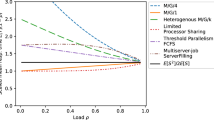Abstract
In this paper, we study a multiserver system in which each customer requires a random number of servers simultaneously and a random but identical service time at all occupied servers. This model describes the dynamics of modern high performance clusters. Stability criteria of this system (under exponential assumptions) have been proved earlier for the two-server system only. Using a matrix-analytic approach, we obtain stability criteria of such a system under exponential assumptions and with an arbitrary number of servers.
Similar content being viewed by others
References
Andrews, G. E. (1984). The theory of partitions. Cambridge: Cambridge University Press.
Arthurs, E., & Kaufman, J. S. (1979). Sizing a message store subject to blocking criteria. In Proceedings of the third international symposium on modelling and performance evaluation of computer systems: Performance of computer systems (pp. 547–564). Amsterdam: North-Holland Publishing Co.
Asmussen, S. (2003). Applied probability and queues. New York: Springer.
Brill, P. (1975). System point theory in exponential queues. Ph.D. thesis, University of Toronto.
Brill, P., & Green, L. (1984). Queues in which customers receive simultaneous service from a random number of servers: A system point approach. Management Science, 30(1), 51–68.
Brill, P., & Posner, M. (1981). The system point method in exponential queues: A level crossing approach. Mathematics of Operations Research, 6(1), 31–49.
Brill, P. H. (2008). Level crossing methods in stochastic models. New York: Springer-US.
Brualdi, R. A. (2009). Introductory combinatorics (5th ed.). New York: Pearson.
Chakravarthy, S., & Karatza, H. (2013). Two-server parallel system with pure space sharing and markovian arrivals. Computers & Operations Research, 40(1), 510–519.
Erdős, P. (1942). On an elementary proof of some asymptotic formulas in the theory of partitions. Annals of Mathematics Second Series, 43, 437–450.
Federgruen, A., & Green, L. (1984). An M/G/c queue in which the number of servers required is random. Journal of Applied Probability, 21(3), 583.
Filippopoulos, D., & Karatza, H. (2007). An M/M/2 parallel system model with pure space sharing among rigid jobs. Mathematical and Computer Modelling, 45(5–6), 491–530.
Fletcher, G. Y., Perros, H., & Stewart, W. (1986). A queueing system where customers require a random number of servers simultaneously. European Journal of Operational Research, 23, 331–342.
Gillent, F., & Latouche, G. (1983). Semi-explicit solutions for M/PH/1-like queuing systems. European Journal of Operational Research, 13(2), 151–160. doi:10.1016/0377-2217(83)90077-2.
Green, L. (1978). Queues which allow a random number of servers per customer. Ph.D. thesis, Yale University.
Green, L. (1980a). Comparing operating characteristics of queues in which customers require a random number of servers. Management Science, 27(1), 65–74.
Green, L. (1980b). A queueing system in which customers require a random number of servers. Operations Research, 28(6), 1335–1346.
He, Q. M. (2014). Fundamentals of matrix-analytic methods. New York: Springer.
Ibe, O. C. (2009). Markov processes for stochastic modeling. Amsterdam, Boston: Academic Press.
Ittimakin, P., & Kao, E. P. C. (1991). Stationary waiting time distribution of a queue in which customers require a random number of servers. Operations Research, 39(4), 633–638.
Kaufman, J. (1981). Blocking in a shared resource environment. IEEE Transactions on Communications, 29(10), 1474–1481.
Kim, S. (1979). M/M/s queueing system where customers demand multiple server use. Ph.D. thesis, Southern Methodist University.
Kipnis, C., & Robert, P. (1990). A dynamic storage process. Stochastic processes and their applications, 34(1), 155–169.
Latouche, G., & Ramaswami, V. (1999). Introduction to matrix analytic methods in stochastic modeling. Philadelphia: ASA-SIAM.
Neuts, M. F. (1980). Matrix-geometric solutions in stochastic models. Baltimore: Johns Hopkins University Press.
Neuts, M. F. (1981). Matrix-geometric solutions in stochastic models. Baltimore: Johns Hopkins University Press.
Schaack, C., & Larson, R. C. (1989). An N server cutoff priority queue where arriving customers request a random number of servers. Management Science, 35(5), 614–634.
Seila, A. F. (1984). On waiting times for a queue in which customers require simultaneous service from a random number of servers. Operations Research, 32(5), 1181–1184.
Tikhonenko, O. (2005). Generalized Erlang problem for service systems with finite total capacity. Problems of Information Transmission, 41(3), 243–253.
Van Dijk, N. M. (1989). Blocking of finite source inputs which require simultaneous servers with general think and holding times. Operations Research Letters, 8(1), 45–52.
Whitt, W. (1985). Blocking when service is required from several facilities simultaneously. AT&T Technical Journal, 64(8), 1807–1856.
Acknowledgments
The authors thank Philippe Robert for his valuable comments and attracting attention to the paper (Kipnis and Robert 1990), and Bart Steyaert for some useful suggestions. The authors are also thankful to the anonymous referees for their careful reading and useful comments which have helped us to improve the readability of the paper. This work is supported by Russian Foundation for Basic Research, projects 13-07-00008, 14-07-31007, 15-07-02341, 15-07-02354, 15-07-02360, the organising committee of the ECQT2014 and the Program of strategic development of Petrozavodsk State University.
Author information
Authors and Affiliations
Corresponding author
Rights and permissions
About this article
Cite this article
Rumyantsev, A., Morozov, E. Stability criterion of a multiserver model with simultaneous service. Ann Oper Res 252, 29–39 (2017). https://doi.org/10.1007/s10479-015-1917-2
Published:
Issue Date:
DOI: https://doi.org/10.1007/s10479-015-1917-2
Keywords
- Multi-server systems
- Simultaneous service
- Concurrent server release
- Stability conditions
- Stationary workload
- High-performance cluster
- Supercomputer



